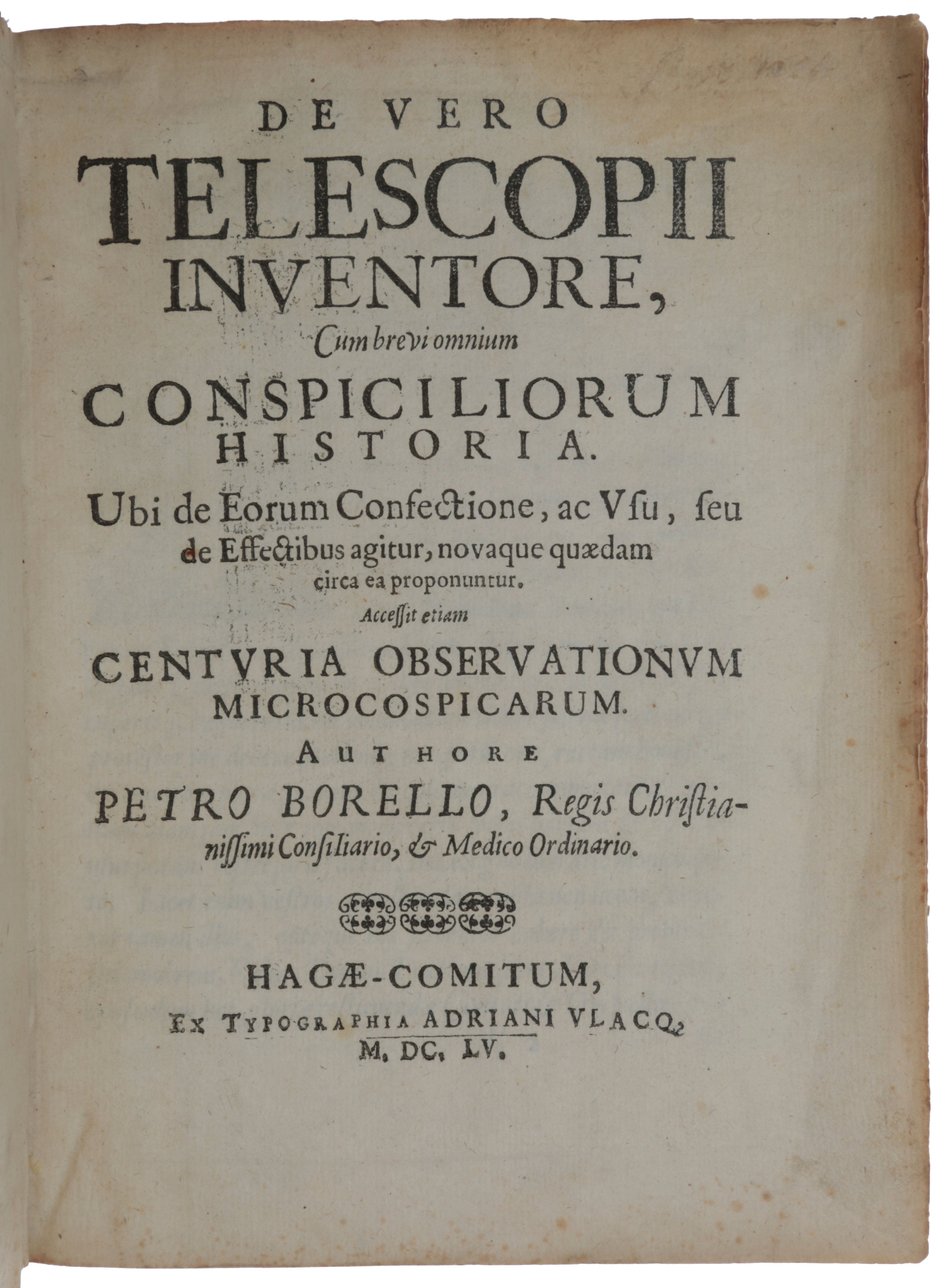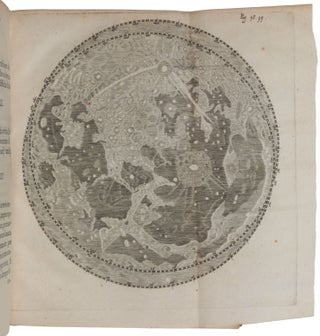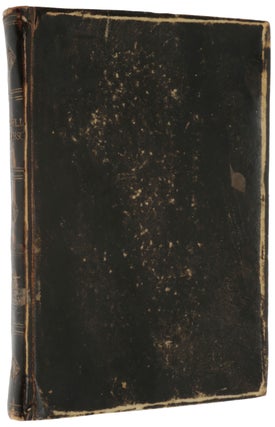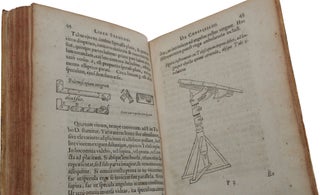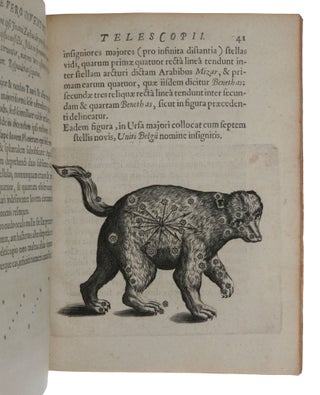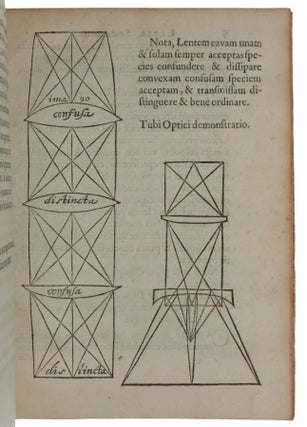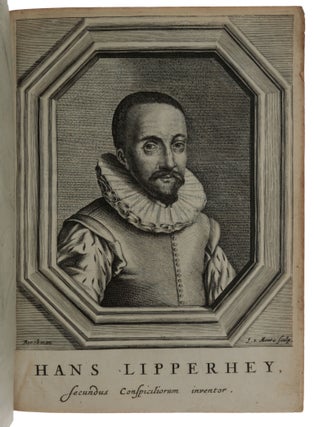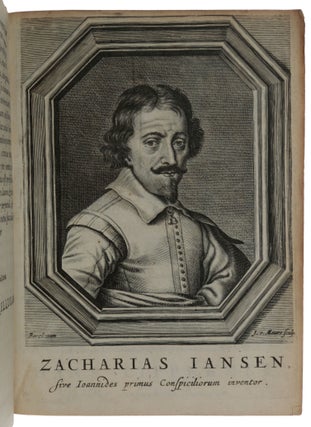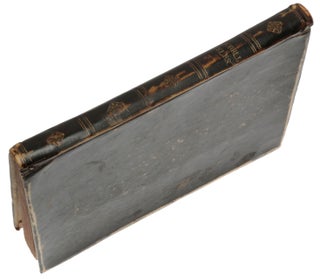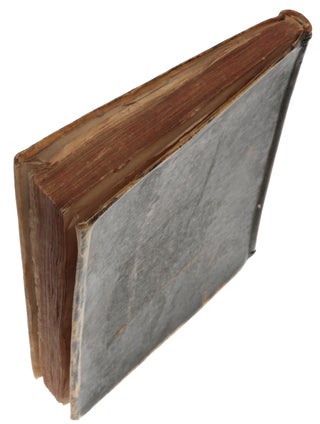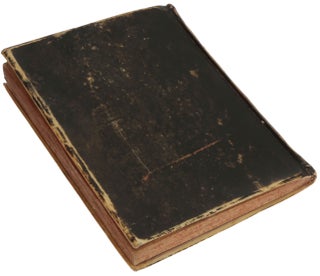De vero telescopii inventore, cum brevi omnium conspiciliorum historia – Observationum microcospicarum centuria.
The Hague: Adriaan Vlacq, 1655-56. First edition, very rare and a fine copy. “In 1656 French physician, chemist, botanist, and savant Pierre Borel published the first documentary history of the invention of the telescope and microscope in De vero telescopii inventore … in The Hague. Borel’s work also contained Christiaan Huygens’s preliminary announcement of his discovery of the rings of Saturn and of the Saturnian moon Titan. Borel’s purpose in compiling his history was to publish the evidence obtained by William Boreel, French ambassador to the Dutch States, supporting the claims of Dutch spectacle-maker Zacharias Jansen to the invention of both the telescope and compound microscope. Jansen’s first claim is not generally recognized (German-Dutch lens-maker Hans Lippershey is traditionally credited with inventing the first telescope), but Jansen probably did invent the compound microscope, the original of which Boreel saw in 1619. One of the several documents that Borel collected for his history was a letter from Christiaan Huygens entitled ‘De Saturni luna observatio nova,’ dated March 5, 1656, recounting his discovery of the Saturnian moon Titan and giving in anagram form his solution to the problem of the mysterious variable ‘arms’ of Saturn. Huygens had concluded that the ‘arms’ were really a single ring surrounding the planet, a solution that, three years later, he announced in Systema Saturnium. By publication of the anagram he was able to establish his priority before full disclosure of the discovery” (historyofinformation.com). Borel, physician to the King of France, was an active collector of rarities, plants, antiquities, and minerals, as well as manuscripts and books of the Hermetic philosophers or chemists. In this work he gives a detailed history of the telescope from the earliest times up to Galileo, Descartes, Metius and numerous others. Borel was the first to apply microscopy to medicine, and the second part of the book is devoted to microscopic observations. It also gives a full account of the construction of telescopes and microscopes and discusses ways to grind lenses for both these instruments. “He also describes a ‘polemoscope’ [periscope], a 1637 invention designed for looking around corners, which is particularly useful in warfare” (DSB). The third part was completed slightly later than the first two and was not included in the first copies issued (see below). ABPC/RBH list three complete copies in the last 40 years. “The search for the inventor of the telescope has a long tradition which began almost immediately after the invention of the instrument. In Telescopium, the earliest book on the telescope, published in 1618, but composed in 1612, Girolamo Sirtori already doubts whether Hans Lipperhey, the first demonstrator of the instrument, was also the inventor of the device … Since then, the search for the inventor of the telescope has continued unabated. One of the most famous and early examples of the genre is Pierre Borel’s De Vero Telescopii Inventore (1656), or ‘the true inventor of the telescope’” (Van Helden, Origins, p. 2). “Sirtori himself downplayed the achievement of the invention by presenting the story of ‘Johannes Lippersein’ [Lipperhey], who would have grasped the idea from ‘a genius or some other man, as yet unknown, of the race of Hollanders,’ who had visited this Middelburg spectacle maker. This visitor supposedly ordered ‘many lenses to be made, concave as well as convex.’ When he returned, the man selected and aligned two lenses, ‘a concave and a convex one,’ and in this way inadvertently revealed the secret of the telescope. Lipperhey ‘by no means devoid of ingenuity, and curious about the novelty’ would have imitated the visitor, and after having joined both lenses in a tube, rushed to the Hague, to the court of Count Maurits, to show him the invention” (Zuidervaart, p. 19). In the Netherlands, an alternative ‘first inventor’ began to emerge – Jacob Adriaensz Metius, the brother of Adriaen Adriaensz Metius, professor of mathematics at the University of Franeker. In the 1614 edition of Adriaen’s Institutiones astronomicae et geographicae, he claimed that around 1608 his brother Jacob had invented the ‘far sights’ (‘verre ghesichten’). For the rest of Europe, Metius’ fame as the inventor of the telescope was established in 1637 by René Descartes in La Dioptrique, an appendix to his famous Discours de la Méthode, in which Descartes gave an account of Metius’ invention, a story he had probably heard from Adriaen Metius himself, when, in 1629 as a student at Franeker University, he had attended Metius’ lectures on optics. “In the Netherlands Metius’ fame as the inventor of the telescope remained virtually unchallenged until 1655. That year Sir Willem Boreel gave his judgment. He was a Middelburg-born diplomat, knighted in 1618 by the English king. At the time, Boreel was ambassador of the Dutch Republic at the French court. In France Boreel had been acquainted with Pierre Borel, a court physician with a keen interest in optics. Because, in his influential Oculus Enoch et Eliae of 1645, Schyrl de Rheita had paraphrased the story published by Sirtori in 1618, the name of ‘Ioannes Lippensum of Zeeland’ had reappeared on the scene. In discussions about the invention of the telescope with Borel and others, Boreel had been annoyed about the fact that it seemed that ‘everyone seeks to claim the honour of that invention for himself.’ For instance ‘Galilei, Welser, and Metius of Alkmaar had assumed that honour, or it has been ascribed to them, especially to the last.’ But according to Boreel, in his youth, he personally had known the ‘man who is said to have been the first inventor of the said telescopes.’ As Boreel was ‘always eager to contribute anything that can add to the honour and renown of my fatherland,’ he persuaded Borel to compose a documented account about this ‘true inventor of the telescope.’ To assist Borel in this noble enterprise, Boreel addressed the Middelburg magistrates with an official request. According to Boreel, the honour of the invention belonged to Middelburg, and he desired to establish this fact once and for all by means of a properly documented investigation. In his request Boreel presented the following description of the person he remembered to be the inventor of the telescope: ‘This man lived in Middelburg in the Capoen Street, on the left side coming from the Green Market, in about the middle of the block, in the little houses against the New Church. He was a man of small means, had a modest shop, and many children, whom I still saw afterwards when I came back to Middelburg when I was older.’ “A request from such an esteemed person had to be taken very seriously, so the Middelburg magistrates appointed Jacob Blondel, one of their senior members, as official investigator to search for witnesses who could testify about what had happened half a century earlier. Blondel’s task did not appear to be very difficult, for Boreel’s description of the inventor and his modest shop fitted exactly with that of the late Hans Lipperhey and the location of his former spectacle workshop in the Middelburg ‘Capoenstraat.’ Lipperhey had indeed been a modest man, and had had at least seven children. So Blondel rather quickly succeeded in finding three witnesses, a former son-in-law and two former neighbours, all of whom confirmed that Hans Lipperhey had indeed constructed ‘verresiende brillen oft verrekijckers’ in his shop at the Capoen Street, having a sign representing some telescopes. So everything seemed to confirm Boreel’s initial memory. “However, at the end of January 1655, just before the investigation ended, two new witnesses suddenly stepped forward, presenting a completely different account of what had happened some fifty years before. The main witness was Johannes Sachariassen, a skilled lens grinder living in Middelburg, who claimed that his father, the late Zacharias Jansen, was the true inventor. His aunt Sara Goedaerts, Zacharias’ only sister, supported his claim. According to Sachariassen’s account his father had invented the telescope, not in 1608, but already in the year 1590. Of these first telescopes, having a length of about 16 inches, one had been presented to Count Maurits and another one to Archduke Albertus. In the year 1618 he and his father had invented the longer telescopes, which were used for observing the stars and the moon at night. Shortly thereafter, in 1620, (Adriaen) Metius and Cornelis Drebbel had come to their shop to buy such a telescope, which both of them had later tried to copy. According to Sachariassen, it was very regrettable that ‘Reynier Ducartes,’ Cornelis Drebbel and the former medal maker Johannes Loo were not alive anymore, for they would surely have confirmed his testimony. “In March 1655, these testimonies were sent to ambassador Willem Boreel in Paris. What happened next is remarkable. In July 1655, in a letter to Borel, Boreel rephrased his earlier statement about the invention of the telescope. He now followed the testimony of Sachariassen almost to the letter, and added some other particulars. Briefly, Boreel’s statement was as follows: in 1591 (the year he was born), near his birthplace in Middelburg, a spectacle maker lived in a house built against the New Church. His name was Hans and he had a wife called Maria. They had three children: two daughters and a son. As a child, Boreel had often played with this boy, called Zacharias. In those days he also frequented their workshop. At one of those occasions he had heard that Hans and Zacharias had first invented the microscope, and after that, the telescope. This lucky event had to be dated around 1610. In 1619, when Boreel visited London, he had seen a microscope at Cornelis Drebbel’s house, which according to his memory was made by the two Jansens. As far as Lipperhey was concerned, Boreel now rather closely followed Sirtori’s earlier account about the unknown visitor, who by a twist of fate had called upon Lipperhey, although he had actually been looking for the Jansens. Lipperhey, being a keen spectacle maker, had listened closely to the visitor, and after his departure he had reconstructed the device, solely by the sharpness of his mind. So, according to Boreel, although Jansen had been the first, surely Lipperhey deserved to be called the second inventor. “Pierre Borel, now being presented with two Middelburg candidates for the invention, did not hesitate in drawing his own conclusions. Boreel’s high social status did not allow for any objections to be made, so in his book De Vero Telescopii Inventore, published in the Hague in 1656, Borel presented the hitherto unknown Zacharias Jansen as the first inventor and Hans Lipperhey as the second. Thus, Jansen’s claim for the invention remained the favoured one for many decades to come” (Zuidervaart, pp. 21-26). Borel also credits Jansen with the invention of the microscope. “The invention of the microscope followed [that of the telescope] at some unknown date. The event is thus described by Willem Boreel in a letter to the Frenchman, Pierre Borel: ‘… When I was ambassador to England in the year 1619, the Dutchman Cornelius Drebbel of Alkomar, a man familiar with many secrets of nature, who was serving there as mathematician to King James, and was well known to me, showed me that very instrument which the Archduke had presented as a gift to Drebbel, namely, the microscope of Zacharias himself. Nor was it (as they are now seen) with a short tube, but nearly two and a half feet long, and the tube was of gilded brass two fingers breadth in diameter, and supported on three dolphins formed also of brass. At its base was an ebony disc, containing shreds or some minute objects which we inspected from above, and their forms were so magnified as to seem almost miraculous’ (p. 29). This report is supported in almost every detail by evidence collected by Pierre Borel from the town councillors of Middelburg” (Singer, pp. 257-259). “After distinguishing himself in mathematics, Huygens began a career as an astronomer, devoting himself to both the technical and observational aspects of the discipline. He solicited detailed instructions on lens-grinding from the best craftsmen in Europe, and built a 12-foot telescope with his brother, Constantijn. Within a year he had used his instrument to compile an impressive series of observations of Saturn. On 25 March 1655 he began following a small star in the vicinity of Saturn, and within three months had established the period of revolution for this loyal star (now known as the moon Titan) at 16 days, 4 hours. “Huygens needed a tool with which to claim his discovery of the moon and its period of orbit. The tool he chose was an anagram – a private epistolary declaration of a concealed fact: admovere oculis distantia sidera nostris, vvvvvvvcccrrhnbqx. This he sent in letters to two fellow astronomers, John Wallis at Oxford and Gottfried Aloys Kinner in Prague … The anagram afforded Huygens more time to confirm his theory, which he did in January 1656 when Saturn reappeared. In the interval he had constructed a 23-foot telescope which he used to confirm his theory of Saturn’s moon. Additionally, the sharp images of this instrument allowed him to speculate further as to the reasons for the planet’s ambiguous shape … “Huygens felt both pressure to announce his discoveries and concern over the compromise publication entailed … His friend and correspondent Jean Chapelain, however, advised him to publish … Finally, Huygens listened to Chapelain’s admonishment, and the eventual result was De Saturni Luna, published in early March, 1656. The work’s two pages of text described in relatively general terms how Huygens tracked the satellite following Saturn. No original copies survive … “Once De Saturni Luna was printed, Huygens received at least fifteen copies from the printer Adrain Vlacq for his own distribution, but in an interesting bibliographic twist the work also appeared as a supplement to Pierre Borel’s De vero telescopii inventore, which was for sale. The decision to add De Saturni Luna to Borel’s book seems to have been Vlacq’s … “Borel’s book 2, De Conspiciliis, ended on page 61, and below it Vlacq included a note, ‘Typographus Lectori’, which introduced Huygens’ contribution as a unique telescopic discovery. It commences on page 62, but with an obvious error. The title is printed as De Saturni Luna Observatio Nona, as opposed to Nova. Albert van Helden has speculated that Huygens would have caught such an error before he circulated his own copies, a notion which is corroborated by the fact that the recipients of the work used the correct title when they thanked him for it. Moreover, in a letter from Henry Oldenburg to Saporta on 11 August 1659, Oldenburg quotes a sentence from De Saturni Luna in which a single word differs from the version printed in Borel’s work. It is clear then that Oldenburg was looking at a different edition than what Vlacq printed conjointly … [Thus,] in March 1656 there were two editions of De Saturni Luna: one printed for Huygens’ personal distribution and another as an addendum to a publicly available work by Borel … “Huygens began the text of De Saturni Luna with a first person account of observations … Huygens described how he first observed the satellite and then showed it to friends over a period of time. He was careful to recognise the efforts of others in the field who had also observed Saturn, including the Bohemian astronomer Anton Maria Schyrlaeus de Rheita and Johannes Hevelius. Aside from these two, however, he claimed to know of no one else who had published a work about this planet or its satellites, or who had ventured a coherent theory about its changing appearance … “After introducing the moon of Saturn and establishing its orbit, Huygens promised the reader that his complete system of Saturn (by which he meant his ring theory) would be made public after additional observations are taken. In the meantime, he writes, ‘it seems useful to consign the essentials [of the system] to the following anagram, such that, if perhaps anyone believes to have found the same thing, he has the time to make it known and he will not be said to have taken it from us, nor we from him. The anagram read: aaaaaaacccccdeeeeehiiiiiiillllmmnnnnnnnnnooooppqrrstttttuuuuu Once solved, it postulated that ‘Saturn is encircled by a thin, flat ring, nowhere touching, inclined to the ecliptic.’ Unlike the one he had sent to Wallis and others in an earlier letter, this anagram was semi-public: it told a selective readership that a secret existed, but again did not reveal the underlying theory” (Howard). Huygens continued making observations of Saturn, finally publishing them, with a solution of his anagram, in his Systema Saturnium in 1659. The third part of De Vero Telescopii Inventore describes observations made by Borel with a microscope. “In 1655 Borel issued a work on the telescope with which is bound up a series of one hundred microscopic observations, mainly on minute insects, with a few crude illustrations. The separate issue of these microscopic observations a few months later constitutes the first book devoted to microscopy” (Singer, p. 274). Howard (p. 482) states that Vlacq published the book just after he had received De Saturni Luna from Huygens, and before he had received the third part from Borel. Some copies were indeed issued without the Centuria, for example one of the two copies digitized on BSB and that in the ETH, Zürich, digitized on e-rara. Moreover, the Centuria, which has its own title-page, was also issued separately, as stated by Singer (there is a copy in the Science Museum, London). Garrison-Morton 261; NLM/Knivatsy 1569; Wellcome II, p. 204; Norman 268. Howard, ‘Rings and anagrams: Huygens’s system of Saturn,’ The Papers of the Bibliographical Society of America 98 (2004), pp. 477-510. Singer, ‘Notes on the early history of microscopy,’ Proceedings of the Royal Society of Medicine (Sect Hist Med) 7 (1914), pp. 247-279. Van Helden et al (eds.), The Origins of the Telescope, 2010. Zuidervaart, ‘The ‘true inventor’ of the telescope. A survey of 400 years of debate,’ pp. 9-44 in Van Helden et al., loc cit.
Three parts in one volume, 4to (202 x 152 mm), pp. [viii], 67, [1, blank], 63, [1, blank], [1-6], 7-45, [3, index], [1, errata], [1, blank], with two fine engraved portraits of Zacharias Janssen and Hans Lipperhey by J. van Meurs after Berckman (not included in the collation), two copper-engravings (one folding full-page and one half-page), several woodcuts in text, one showing a telescope, separate title-page to Centuria. Contemporary black vellum with gilt spine. A very fine copy, entirely untouched.
Item #5415
Price: $95,000.00

